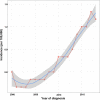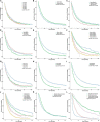Incidence Trend and Competing Risk Analysis of Patients With Intrahepatic Cholangiocarcinoma: A Population-Based Study
- PMID: 35433765
- PMCID: PMC9005886
- DOI: 10.3389/fmed.2022.846276
Incidence Trend and Competing Risk Analysis of Patients With Intrahepatic Cholangiocarcinoma: A Population-Based Study
Abstract
Background: Intrahepatic cholangiocarcinoma (ICCA) is a primary liver cancer characterized by rapid progression and poor prognosis. There are few effective tools for evaluating the prognosis of ICCA patients, and the use of liver transplantation (LT) of the treatment for ICCA is still controversial.
Methods: We analyzed ICCA incidence data and clinicopathological data from the Surveillance, Epidemiology, and End Results database. Prognostic predictors were identified by univariate and multivariate Cox regression analyses and then used to establish a nomogram. The prediction performance of the nomogram was evaluated with receiver operating characteristic (ROC) curves, calibration plots and decision curve analysis (DCA) plots. Propensity score matching (PSM) was used to balance the baseline data of patients undergoing LT and other operations, and then, univariate Cox regression analysis was used to evaluate the therapeutic value of LT for ICCA.
Results: The incidence of ICCA increased significantly, from 0.6 per 100,000 in 2,000 to 1.3 per 100,000 in 2018. The median overall survival (OS) of the patients was 13 months, and the 1-, 3-, and 5-year OS rates were 51.40, 22.14, and 13.79%, respectively. Cox regression analysis showed that age under 60 years old, female, tumor size ≤ 50 mm, better differentiation, smaller range of tumor invasion, lack of distant metastasis, regional lymph node surgery and treatment were associated with a better prognosis. The ROC curves, calibration plots, and DCA plots showed that the nomogram had good discrimination and calibration power, as well as clinical utility. After PSM, the univariate Cox regression analysis showed no significant difference in OS between patients treated with LT and patients treated with other operations.
Conclusion: The incidence of ICCA increased significantly. A nomogram with good predictive performance was developed to predict the OS of ICCA patients. LT might be considered as a potential option for some ICCA patients.
Keywords: intrahepatic cholangiocarcinoma; liver transplantation; nomogram; prognosis; risk factor.
Copyright © 2022 Xing, Tan, Yang and Zhang.
Conflict of interest statement
The authors declare that the research was conducted in the absence of any commercial or financial relationships that could be construed as a potential conflict of interest.
Figures












Similar articles
-
Prediction of the prognosis of intrahepatic cholangiocarcinoma patients after hepatectomy via propensity score matching: a competitive risk model analysis.Transl Cancer Res. 2025 Mar 30;14(3):1884-1901. doi: 10.21037/tcr-24-1819. Epub 2025 Mar 25. Transl Cancer Res. 2025. PMID: 40225005 Free PMC article.
-
Development and Validation of Nomograms for Predicting Cancer-Specific Survival in Elderly Patients with Intrahepatic Cholangiocarcinoma After Liver Resection: A Competing Risk Analysis.Cancer Manag Res. 2020 Nov 2;12:11015-11029. doi: 10.2147/CMAR.S272797. eCollection 2020. Cancer Manag Res. 2020. PMID: 33173335 Free PMC article.
-
A Myeloid Signature-Based Nomogram Predicts the Postoperative Recurrence of Intrahepatic Cholangiocarcinoma.Front Mol Biosci. 2021 Oct 13;8:742953. doi: 10.3389/fmolb.2021.742953. eCollection 2021. Front Mol Biosci. 2021. PMID: 34722632 Free PMC article.
-
Ablative Therapy for Unresectable Intrahepatic Cholangiocarcinoma: A Systematic Review and Meta-Analysis.J Clin Exp Hepatol. 2019 Nov-Dec;9(6):740-748. doi: 10.1016/j.jceh.2019.08.001. Epub 2019 Aug 19. J Clin Exp Hepatol. 2019. PMID: 31889756 Free PMC article. Review.
-
Liver Transplantation for Intrahepatic Cholangiocarcinoma: What Are New Insights and What Should We Follow?Front Oncol. 2022 Jan 21;11:841694. doi: 10.3389/fonc.2021.841694. eCollection 2021. Front Oncol. 2022. PMID: 35127541 Free PMC article. Review.
Cited by
-
Competitive risk analysis of the therapeutic value of liver transplantation for liver cancer in children: A population-based study.Front Surg. 2022 Aug 31;9:938254. doi: 10.3389/fsurg.2022.938254. eCollection 2022. Front Surg. 2022. PMID: 36117822 Free PMC article.
-
Genetic alterations of KRAS and TP53 in intrahepatic cholangiocarcinoma associated with poor prognosis.Open Life Sci. 2023 Jul 17;18(1):20220652. doi: 10.1515/biol-2022-0652. eCollection 2023. Open Life Sci. 2023. PMID: 37483430 Free PMC article.
-
Identification of biomarkers associated with exhausted CD8 + T cells in the tumor microenvironment of intrahepatic cholangiocarcinoma based on Mendelian randomization and bioinformatics analysis.Discov Oncol. 2025 Jun 13;16(1):1092. doi: 10.1007/s12672-025-02970-w. Discov Oncol. 2025. PMID: 40514625 Free PMC article.
-
Integrative Analysis of Intrahepatic Cholangiocarcinoma Subtypes for Improved Patient Stratification: Clinical, Pathological, and Radiological Considerations.Cancers (Basel). 2022 Jun 28;14(13):3156. doi: 10.3390/cancers14133156. Cancers (Basel). 2022. PMID: 35804931 Free PMC article.
-
The Epidemiology of Biliary Tract Cancer and Associated Prevalence of MDM2 Amplification: A Targeted Literature Review.Target Oncol. 2024 Nov;19(6):833-844. doi: 10.1007/s11523-024-01086-5. Epub 2024 Sep 20. Target Oncol. 2024. PMID: 39302603 Free PMC article. Review.
References
LinkOut - more resources
Full Text Sources
Miscellaneous

